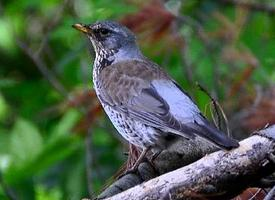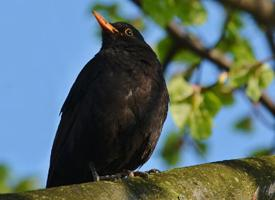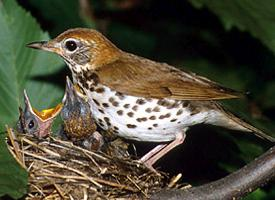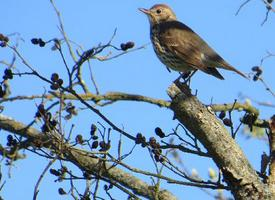
Súlyok és méretek
| Hossz | 24-tól 27-ig cm |
|---|---|
| Súly | 80-tól 140-ig g |
| Szárnyfesztávolság | 39-tól 43-ig cm |
Állatleírás
The Fieldfare (Turdus pilaris) is a striking and gregarious bird that belongs to the thrush family, Turdidae. Known for its robust build and distinctive plumage, this bird is a captivating sight in the wild. It is primarily a migratory species, with breeding grounds across the northern regions of Europe and Asia and wintering areas further south in Europe, North Africa, and parts of the Middle East. The Fieldfare's migratory patterns showcase its adaptability and the significant distances it travels in pursuit of favorable climates and feeding grounds.Physical Description:
The Fieldfare is a medium-sized bird, measuring approximately 22 to 27 cm in length, with a wingspan of 34 to 38 cm. It has a strong, chunky appearance, with a relatively large head and a thick bill that is adept at foraging for a variety of foods. The adult Fieldfare's plumage is quite distinctive and beautiful. Its head, nape, and rump are a striking gray, while the back and wings exhibit a rich, chestnut-brown. The bird's underparts are lighter, adorned with a pale yellowish color, and conspicuously spotted and streaked with black. Its tail is dark, and the flight feathers show a contrasting pattern of dark and light during flight. Male and female Fieldfares are similar in appearance, though the females may be slightly duller in color.
Behavior and Ecology:
Fieldfares are highly social birds, especially outside the breeding season when they can be found in large flocks. These flocks can sometimes number in the thousands, particularly in winter feeding grounds, where they search for berries, fruits, and insects. During the breeding season, however, they become more territorial and are often found in smaller groups or pairs. Their nests are typically built in trees, and they exhibit a strong communal instinct to protect their nesting sites from predators, often mobbing intruders en masse.
Fieldfares have a varied diet that changes with the seasons. In summer, their diet primarily consists of invertebrates, including worms, insects, and snails. Come winter, they switch to a diet of berries and fruits, which they often find in abundance in hedgerows and woodland edges. This adaptability in diet is key to their survival, especially in their wintering grounds where food sources can vary.
Vocalizations:
The Fieldfare's song is a beautiful and intricate melody, characterized by a series of chattering and melodious notes. They also have a harsher alarm call, which is often heard when they are mobbing predators. Their vocalizations play a crucial role in social interactions within flocks and in signaling the presence of potential threats.
Conservation Status:
Currently, the Fieldfare is classified as Least Concern by the International Union for Conservation of Nature (IUCN), indicating that it is not currently at significant risk of extinction in the wild. However, like many bird species, it faces threats from habitat destruction, pollution, and climate change, which could impact its numbers and distribution in the future.
In summary, the Fieldfare is a fascinating bird with a distinctive appearance, interesting behaviors, and a wide range that spans continents. Its adaptability and social nature make it a resilient species, capable of thriving in a variety of environments, but it remains vulnerable to the broader challenges facing global biodiversity.
Hasonló állatok
Új állatfotók
Top 10 állat
- Dolphin gull (Leucophaeus scoresbii)
- Japanese macaque (Macaca fuscata)
- Stone loach (Barbatula barbatula)
- Galápagos tortoise (Geochelone nigra complex)
- Russian tortoise (Testudo horsfieldii)
- Diana monkey (Cercopithecus diana)
- Greek tortoise (Testudo graeca)
- Common flying dragon (Draco volans)
- Moustached guenon (Cercopithecus cephus)
- Galápagos penguin (Spheniscus mendiculus)


